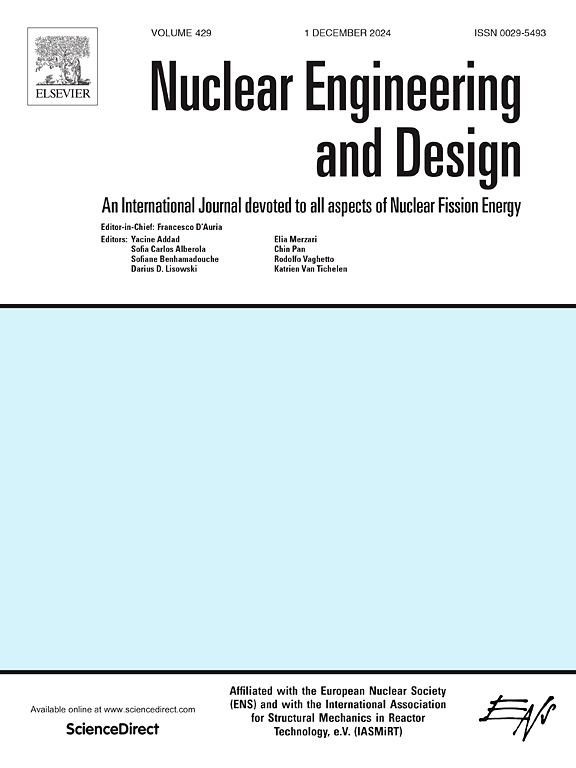Material cross-sections real-time inversion from neutron detector data for nuclear reactor digital twin
IF 1.9
3区 工程技术
Q1 NUCLEAR SCIENCE & TECHNOLOGY
引用次数: 0
Abstract
The Nuclear Reactor Digital Twin (NRDT) has garnered significant attention in recent years. One of the crucial aspects in NRDT is the real-time inversion of nuclear reactor core material cross-sections during reactor operation. In general, an inverse problem is solved by combining multiple iterations of the forward problem with an optimization algorithm. Even though the development of a surrogate model has significantly enhanced the computational efficiency of forward problems, the iteration process still poses a challenge to real-time inversion. To address this problem, this paper presents a real-time inverse problem solver (RIPS). During the offline stage, RIPS establishes a mapping between the sparse neutron detector data and the cross-sections through the reduced-order model and radial basis function. During the online stage, the corresponding cross-section can be calculated directly using the mapping and neutron detector data. Since the RIPS eliminates the multiple iterations of traditional methods, the efficiency of RIPS can be improved by orders of magnitude, and enables real-time online calculation. Three typical numerical benchmarks are tested for verification in this paper, which proves that the maximum relative error of RIPS does not exceed 0.54 % and the average relative error does not exceed 0.1986 %. Furthermore, for each test case, the calculation time of RIPS is within 0.01 s. This work can provide useful suggestions and applications, and further development in cross-section inversion.
核反应堆数字孪生体中子探测器数据的材料截面实时反演
近年来,核反应堆数字孪生体(NRDT)引起了人们的极大关注。核反应堆运行过程中堆芯材料截面的实时反演是NRDT技术的一个重要方面。一般来说,反问题的求解是将正问题的多次迭代与优化算法相结合。尽管代理模型的发展大大提高了正演问题的计算效率,但迭代过程仍然对实时反演提出了挑战。为了解决这个问题,本文提出了一个实时逆问题求解器(RIPS)。在离线阶段,RIPS通过降阶模型和径向基函数建立了稀疏中子探测器数据与截面之间的映射关系。在在线阶段,可以直接利用测图和中子探测器数据计算相应的截面。由于RIPS消除了传统方法的多次迭代,因此可以将RIPS的效率提高几个数量级,并且可以实现实时在线计算。本文通过三个典型的数值基准测试进行验证,证明了RIPS的最大相对误差不超过0.54%,平均相对误差不超过0.1986 %。而且,对于每个测试用例,RIPS的计算时间都在0.01 s以内。本文的工作为进一步发展剖面反演提供了有益的建议和应用。
本文章由计算机程序翻译,如有差异,请以英文原文为准。
求助全文
约1分钟内获得全文
求助全文
来源期刊

Nuclear Engineering and Design
工程技术-核科学技术
CiteScore
3.40
自引率
11.80%
发文量
377
审稿时长
5 months
期刊介绍:
Nuclear Engineering and Design covers the wide range of disciplines involved in the engineering, design, safety and construction of nuclear fission reactors. The Editors welcome papers both on applied and innovative aspects and developments in nuclear science and technology.
Fundamentals of Reactor Design include:
• Thermal-Hydraulics and Core Physics
• Safety Analysis, Risk Assessment (PSA)
• Structural and Mechanical Engineering
• Materials Science
• Fuel Behavior and Design
• Structural Plant Design
• Engineering of Reactor Components
• Experiments
Aspects beyond fundamentals of Reactor Design covered:
• Accident Mitigation Measures
• Reactor Control Systems
• Licensing Issues
• Safeguard Engineering
• Economy of Plants
• Reprocessing / Waste Disposal
• Applications of Nuclear Energy
• Maintenance
• Decommissioning
Papers on new reactor ideas and developments (Generation IV reactors) such as inherently safe modular HTRs, High Performance LWRs/HWRs and LMFBs/GFR will be considered; Actinide Burners, Accelerator Driven Systems, Energy Amplifiers and other special designs of power and research reactors and their applications are also encouraged.
 求助内容:
求助内容: 应助结果提醒方式:
应助结果提醒方式:


